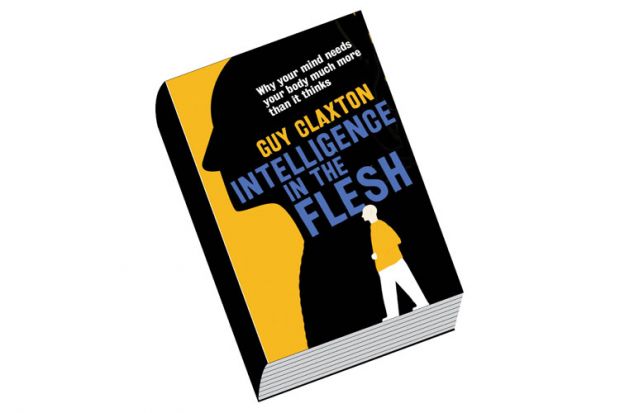If there’s anything that the recent panic over artificial intelligence and robots’ supposed existential threat to the human race has shown, it’s that some very smart people know very little about their own intelligence. The prognostications of Elon Musk and Stephen Hawking, even more than the recent death of Oliver Sacks, make the publication of Guy Claxton’s Intelligence in the Flesh particularly timely. Claxton, who self-identifies as a cognitive scientist, here offers a book that reassuringly extends well beyond even the broad interdisciplinary bounds that such a claim entails, such as linguistics and logic, to take in neuroscience, experimental psychology and a smattering of philosophy.
Intelligence is not just what you know that you know. Intelligence is the unknowing bits of you that are how you know that you know; all that underlies all the behaviour you express that goes beyond the rudiments of physics and metabolism. That definition may still be too conservative. In his introduction, Claxton argues that to identify our minds with only our brains rather than our full being is a form of archaic Cartesian dualism – a critical point for transhumanists hoping to achieve immortality by employing whole-brain scanning to upload their minds to computers. Claxton speeds along through a well-intentioned effort to convince us to pay more attention to our bodies, to embrace the theory of the extended mind, as postulated by the University of Edinburgh’s Andy Clark. Under Clark’s hypothesis, one of the unique aspects of human intelligence is the capacity to manipulate our environments to improve our own cognition. Thus we as individuals are smarter because of our books, lists and gadgets, and to the extent that we exploit these objects, they as well as our bodies become part of our minds.
I shouldn’t jump ahead of the story, though. Claxton does care about the body, and he does a beautiful job of communicating quickly in just a few chapters the many unintuitive aspects of our physical intelligence. All of sensing can be thought of as a form of touch, as a felt response to the prodding of the body. (If you’re sceptical that this can be extended to vision, so was I.) From showing the immense computational requirements and capacities of our bodies as a whole (do you think digestion is easy? or breathing?) he quickly skips to showing the utility of the brain for coordinating all this intelligence, expressing clearly the basics of action selection – the eternal problem of what to do next when competing available options would require mutually exclusive control of the same resource.
Actually, “action selection” is a typically top-down AI term for what is really a procession through time of a complex system coordinated through mutual feedback. Claxton describes beautifully undulating waves of perception and action, the two inseparable sides of the coin of intelligence. If we imagine action as the peak (although it could equally be the trough) then learning occurs on the downward slope as the body perceives whether its action’s outcome matches the expectations that lead to its expression. Claxton describes intelligence as a dancing complex of “Needs, Deeds, and See’ds” – motivating drives, behavioural capacities and perceived opportunities, respectively – unified by a body.
Claxton’s interests extend also to traditional and alternative therapeutic psychology. He reminds us of Plato’s model of human nature as two horses (one the passions, the other the virtues) under the hand of a skilled charioteer, then shows how directly Freud mapped these to the black-stallion id, the white-stallion superego and the ego charioteer (who seems to have lost a little status and balance since Plato’s day). In the next paragraph, Claxton blasts the limitations of my own 1980s-vintage psychology degree, based on 1960s neuroscience that “coincidentally” found the brain to consist of three parts: the old reptilian coordinating ego, the emotion-providing limbic-system id and the rational neocortex superego, here fully ascendant and in control, in a very Cold War kind of way. Claxton’s own model is more contemporary, European and politically correct: reason and emotion are not sworn enemies but “lifelong partners who occasionally tread on each other’s toes”. This may sound hokey, but Claxton’s model is strikingly better motivated and supported than the more familiar theory of emotional intelligence. EI may rightly defend emotionality as essentially human, but still often fails to recognise emotions and reason as two very different, but completely interdependent, aspects of human intelligence.
Intelligence in the Flesh flows seamlessly, aside from chapter breaks, from metabolism to emotions to words and concepts. In chapter 8, Claxton romps through consciousness, carrying on to Clark’s extension of the mind past the body, through what of our environment the body has in its reach, where that reach is extended with tools, including our society. The pace is high, the content dense, and Claxton’s tone is (sometimes disconcertingly) familiar. Nor is he afraid to offer advice. After discussing the impressive intelligence involved in unglamorous work such as waiting tables, he moves on to the positive impact of physical creation on emotional state and self-concept. From here he muses: “People [currently often] become their own most highly crafted product and performance. Nothing wrong with that, but it becomes so prevalent and so obsessive for some, perhaps, precisely because the opportunities for physical making and doing in schools and elsewhere are held in such low esteem.”
The reason I became a roboticist is because the University of Edinburgh had a Lego robot course on their MSc, and I thought “This might be my last chance to do something with my hands.” Of course it wasn’t, but that fear propelled me unexpectedly into what I still consider the most interesting subfield of AI. Robotic intelligence is interesting specifically because it contacts the physical world, and in being embodied, shines bright light on some of the least illuminated aspects of our own intelligence.
As a reviewer, I should be doing at least two things with this book. The one I’m most confident about is checking for accuracy. Claxton is not only reviewing a broad range of contemporary literature but also synthesising his own spin over contemporary theories, creating a novel collection and interpretation of the ideas of our peers. For this task I feel competent, at least for the first 10 non-clinical chapters. I spotted a few gaffes in physics, evolutionary biology and economics, and with more column inches I might debate the finer points of his theories of emotions or consciousness. I’m slightly wary of some of the sources he cites in his chapters on relevance to therapy and spirituality. But, overall, I’m deeply impressed. To be honest, despite the influence of embodiment champions such as Mark Johnson, Rod Brooks and Dan Dennett on my own career, I have seldom been convinced that their accounts got all the way down (or up) from physics to cognition. This book does good work filling in the lacunae.
But my prior knowledge of embodiment theory makes me less confident in my second task: judging this book for its power to communicate. What if you came to it with no knowledge of embodiment theory, or of contemporary neuropsychology? My final-year undergraduates are profoundly sceptical at being told that the mind can be approached from the biological and computing sciences, or that more of it is devoted to sensing and action than logic; that human reasoning originates within and depends upon a context of emotional and physical constraints. My students (mostly) overcome their scepticism by building intelligence directly. Here, Claxton offers the advantages of theories and experiments drawn from a wide range of thinkers, illustrated by visualisations and vignettes drawn from everyday experience, often of the author himself, who unabashedly offers his male, married, middle-aged-academic self as an everyman.
Joanna Bryson is reader in artificial intelligence, University of Bath, and is currently on sabbatical as visiting fellow at Princeton University’s Center for Information Technology Policy.
Intelligence in the Flesh: Why Your Mind Needs Your Body Much More than It Thinks
By Guy Claxton
Yale University Press, 344pp, £20.00
ISBN 9780300208825
Published 27 August 2015
The author
 Guy Claxton, emeritus professor of the learning sciences, University of Winchester, lives “in West Sussex, with my wife Judith Nesbitt, a director of Tate, who is painstakingly improving my aesthetic sensibility”.
Guy Claxton, emeritus professor of the learning sciences, University of Winchester, lives “in West Sussex, with my wife Judith Nesbitt, a director of Tate, who is painstakingly improving my aesthetic sensibility”.
He was born in Finchley, North London; “I lived there until I was eight, and then in rural Shropshire and at boarding school in Worcester. Boarding school taught me emotional repression (which I am slowly recovering from), and solitary holidays in the countryside taught me self-sufficiency and to make my own amusement – which laid the foundations for life as a scholar and writer.”
Claxton did “unexpectedly well at my O-levels, and this opened up the novel possibility that studiousness might be a craft I could master! And the Precentor of Worcester Cathedral taught us a bit of Freud, which got me excited.”
A double first at the University of Cambridge would seem to bear out his schoolboy promise. However, he admits to having “floundered in chemistry, and was rescued by experimental psychology, which actually encouraged you to think and not just learn. I became very competitive (especially with Richard Morris, now professor of neuroscience at the University of Edinburgh) and was gutted to miss out on the Passingham Prize for best psychology student.”
What does he know now that he didn’t then? “I think I have missed out (until recently) on the benefits and consolations of being a good collaborator. And I have had to learn to be able to write in different registers. My first academic paper was turned down on the grounds that its style was ‘too jaunty’ – and it probably still is (for some people).”
In 2008, Claxton co-founded Winchester’s Centre for Real-World Learning. It gave him the chance to “avoid the drudgery of committee meetings and admin, and to combine scholarship with consultancy – and a lot of fun with my first real collaborator, Bill Lucas”.
The Learning Organisation, in which he plays a key role, is “a spin-out for schoolteachers. We are passionate about showing teachers how easy it is to teach in a way that builds students’ capacity and pleasure in organising learning for themselves (and improving their grades at the same time). Our approach, called Building Learning Power (BLP), is now in schools all around the world – from remote primary schools in Poland and Patagonia to top independent secondary schools in China, Brazil, Australia, and South Africa.”
He adds that at TLO, “We work with all sorts, and get paid anything from nothing to a lot. Polish translations of our basic book have been distributed free, for example. BLP takes will and imagination, not a lot of resources. That’s the beauty of it.”
Is embodied intelligence difficult to sell to the archetypal bookish scholar? “Research shows that strong dualists – people who identify clearly with their minds as opposed to their bodies – are less health conscious. Whether academics tend to be stronger dualists than the average bear, I don’t know. It would be an interesting study.” In any event, he adds, “embodiment is not about being beefy and fast; it’s more akin to tai chi and what’s called ‘interceptive awareness’”.
What gives Claxton hope? “My wife. And the English cricket team, intermittently.”
Karen Shook
后记
Print headline: Stronger than we realised




